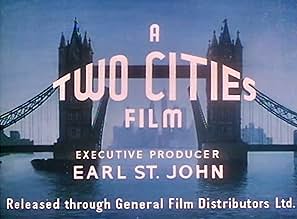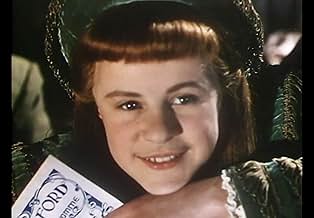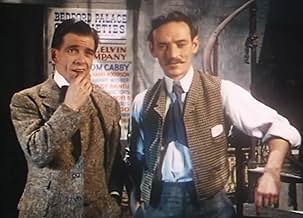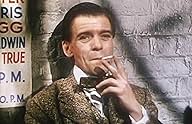अपनी भाषा में प्लॉट जोड़ेंIn the 1890s, Trottie True moves from bit theatre parts to stardom, and from balloonist Sid Skinner to more prominent men. She later wonders if Sid wasn't better after all, and seeks to find... सभी पढ़ेंIn the 1890s, Trottie True moves from bit theatre parts to stardom, and from balloonist Sid Skinner to more prominent men. She later wonders if Sid wasn't better after all, and seeks to find out.In the 1890s, Trottie True moves from bit theatre parts to stardom, and from balloonist Sid Skinner to more prominent men. She later wonders if Sid wasn't better after all, and seeks to find out.
- निर्देशक
- लेखक
- स्टार
Tony Halfpenny
- Perce True
- (as Anthony Halfpenny)
Dilys Laye
- Trottie as a Child
- (as Dylis Lay)
फ़ीचर्ड समीक्षाएं
Jean Kent had everything, real acting ability, a lovely singing voice, and a beautiful face and figure. Only the British Film Industry was short sighted enough not to recognise a Lady who should have been our Number one Star. She was at her best in Trottie True, and I cannot understand why she wasn't snapped up by Hollywood. Only 8 years after this film she was supporting Marilyn Monroe in The Prince and the Showgirl, and still looking ravishing. She is the last surviving Gainsborogh Girl and it is shocking that she seems to have been totally forgotten by the Industry. I saw her at the National Film Theatre in 1999 when they showed Trottie True, and she talked about her career. After the film she came out into the foyer and signed every autograph and posed for photo's, a lovely Lady and a true star.
Designed as a vehicle for Rank's then top star Jean Kent, TROTTIE TRUE is a delightful comedy set in the late Victorian period about the rise and rise of a music-hall star, the eponymous Trottie. From humble beginnings in the provincial theater, she becomes a star of George Alexander's Gaiety Theater, and ends up marrying a Duke (James Donald). The course of true love never does run smooth; and Trottie ends up having marital disagreements over the Duke's perceived lack of interest. However things are resolved amicably in the end, as Trottie discovers that her titled husband is not quite the bounder she first assumed. Brian Desmond Hurst's film offers some delightful vignettes of a world long past, such as the interior of the old Bedford Music Hall where Trottie first becomes a star. The theater was demolished in the mid- Sixties. There are also some wonderful exterior shots of familiar London landmarks such as the Albert Memorial. Kent gives a performance that can best be described as feisty; she will not tolerate misbehavior from anyone, least of all her male beaux. The film also includes some stand-out supporting performances from Bill Owen as Trottie's fellow- performer, and Hattie Jacques in dominant form as a singer with social aspirations.
I first saw Trottie True when it was released . I was already a member of Miss Kent's fan club and she had a magazine full of English stars news.Trottie True was the second film I had seen in colour starring Miss Kent the other one being The Man Within .I am only sorry we still dont see her.
Jean Kent rises from being a child performer in Camden Town in the 1890s to a member of the Gaiety Theater chorus, to the Duchess of Wellwater in a storm-in-a-teacup tumultuous marriage. It's a slight programmer, eked out by Jean Kent's lively performer as a too-candid good girl and by good set and color design. The way cinematographer Harry Waxman shoots the movie, it winds up looking like a series of color rotogravures.
It's derived from one of the eccentric novels of S.J.Simon and Caryl Brahms. While it is not a great movie, Miss Kent's performance is excellent. She had gone on the stage at the age of ten (with her mother) and later worked in the chorus at London's famed Windmill Theater. Doubtless she based her performance on close observation.
It's derived from one of the eccentric novels of S.J.Simon and Caryl Brahms. While it is not a great movie, Miss Kent's performance is excellent. She had gone on the stage at the age of ten (with her mother) and later worked in the chorus at London's famed Windmill Theater. Doubtless she based her performance on close observation.
Trottie True tells the tale of a music hall girl who rises to stardom and soon has to navigate the pitfalls of having too many suitors, and choosing between love and her career.
Jean Kent does seem to be a talented actress but the movie is now dreadfully dated, although having a British movie made in colour in 1949 is quite a find. But the script and direction do not bring the film to life. Many scenes are rushed. There is no care taken in any scenes that show the character development. Even the musical numbers are mostly drawn up short without any respect to members of the audience who might just be enjoying the songs. Everything fades out or cuts at rampant speed, without a chance for the emotional side of the story to properly land. And there is a good story here, and in more skilled hands the characters could have really come to life. As it stands it's all just moving wallpaper. With sound. But much of the dialogue is delivered so fast that you miss a lot of what people are saying
The movie shows it's age most painfully in the songs, which Jean Kent trills her way through in an ear-splitting, high register that I am sure was all the rage when the movie was made, but it just hurt my ears.
The highlights are...well. just that it's a delightful, colourful, period relic. The ladies costumes are mind boggling, especially the never-ending parade of outstanding feathered hats. The acting is broad and unsubtle. I bet Jean Kent could have displayed some impressive depths of emotion but she isn't given a chance. It's the director's fault. There is a lot of plot here. Probably enough for 2 hours, but he filmed like he couldn't bear to spend an inch of celluloid more than was absolutely necessary on any shot or scene. Maybe in 1949, that was a genuine reason for brevity.
Jean Kent does seem to be a talented actress but the movie is now dreadfully dated, although having a British movie made in colour in 1949 is quite a find. But the script and direction do not bring the film to life. Many scenes are rushed. There is no care taken in any scenes that show the character development. Even the musical numbers are mostly drawn up short without any respect to members of the audience who might just be enjoying the songs. Everything fades out or cuts at rampant speed, without a chance for the emotional side of the story to properly land. And there is a good story here, and in more skilled hands the characters could have really come to life. As it stands it's all just moving wallpaper. With sound. But much of the dialogue is delivered so fast that you miss a lot of what people are saying
The movie shows it's age most painfully in the songs, which Jean Kent trills her way through in an ear-splitting, high register that I am sure was all the rage when the movie was made, but it just hurt my ears.
The highlights are...well. just that it's a delightful, colourful, period relic. The ladies costumes are mind boggling, especially the never-ending parade of outstanding feathered hats. The acting is broad and unsubtle. I bet Jean Kent could have displayed some impressive depths of emotion but she isn't given a chance. It's the director's fault. There is a lot of plot here. Probably enough for 2 hours, but he filmed like he couldn't bear to spend an inch of celluloid more than was absolutely necessary on any shot or scene. Maybe in 1949, that was a genuine reason for brevity.
क्या आपको पता है
- ट्रिवियाDaphne Anderson's debut.
- कनेक्शनFeatured in Best of British: Roger Moore (1999)
टॉप पसंद
रेटिंग देने के लिए साइन-इन करें और वैयक्तिकृत सुझावों के लिए वॉचलिस्ट करें
विवरण
- चलने की अवधि
- 1 घं 36 मि(96 min)
- पक्ष अनुपात
- 1.37 : 1
इस पेज में योगदान दें
किसी बदलाव का सुझाव दें या अनुपलब्ध कॉन्टेंट जोड़ें

































